All the garments now in the collection of the Metropolitan Museum of Art in New York that once belonged to Queen Alexandra (1844-1925), consort of King Edward VII of the United Kingdom (1841-1910), came from a landmark auction comprising seventy lots of her clothing and other effects. Intriguingly, this sale also took place in New York, at the American Art Association Anderson Galleries, Inc., located on 30 East 57th Street, in all probability because there were no laws at the time that prevented items of historical value from leaving their country of origin. At the time of the auction, Samuel Wilson Soden, Esq., a court furrier with a shop on Regent Street in London, owned the items, whose sale was conducted according to his instructions on May 5, 1937.1
Below, I have provided a colour image for each of the items that I have been able to find on the Met’s website, with a lot of guidance from Victoriana Magazine’s annotations in the auction catalogue itself.2 I have decided to focus on apparel only, such as gowns, coats, and mantles, because these have historic value or were connected to major events in Queen Alexandra’s life. Therefore, I have paid special attention to clothes from her trousseau (she married in 1863), as well as gowns she wore as a Princess of Wales and later as a Queen consort who was very much in the public eye.
The various lots that made their way into the Met’s collection either have “Gift of Miss Irene Lewisohn, 1937” or “Rogers Fund, 1937” in the credit line. The Royal Ontario Museum in Toronto has a small collection of gowns from the auction, all of which were donated by Colonel Flanagan, a collector.3 However, the rest appear to have mostly vanished without a trace—if you have a clue regarding their whereabouts, please leave a comment.
Identifying the pieces is hard work and requires a lot of guesswork, partly because the 1937 catalogue suffers from a paucity of photographs and incomplete or scanty descriptions (it omits names of designers). Descriptions from the catalogue are in italics (mine) and are numbered from 1 to 30. I have also highlighted items I could not find in yellow:
10. INDIAN WHITE AND GOLD BROCADE GOWN
Of damasse white silk brocaded with gold rosettes and borders; separate skirt in two pieces, the front panel with wide gold border at hem, the back forming a train. Coat-like bodice fastened in front, with long sleeves, high neck, lace jabot and collar. Worn by H. M. Queen Alexandra on the occasion of Queen Victoria’s Jubilee, when Her Majesty rode around London with Queen Victoria; woven especially for Her Majesty for that occasion and brought over by Viscount Hardinge; also worn at Ascot on Gold Cup Day.

Where did it go?
16. GOLD EMBROIDERED WHITE SATIN GOWN
White satin embroidered in gold thread, gold sequins, and rhinestones, with an Empire design of laurel leaves in garlands and wreaths. In one piece, bodice with short bolero and short puffed sleeves trimmed with white tulle. With train. Worn by H. M. the Queen at the wedding of Grand Duchess Xenia, daughter of Czar Alexander III, at Peterhof Palace.

I am fairly certain that the Royal Ontario Museum is the proud owner of the “gold embroidered white satin gown” these days, but I cannot prove this with a photograph, since its online database lists only a limited number of garments from its collection, none of which belonged to Queen Alexandra.
17. EMBROIDERED WHITE SILK COAT AND SCARLET BASHLIK
White faille silk coat, beaded and fringed; and scarlet bashlik with gold embroidery.
A white silk coat by Dieulefait & E. Bouclier that entered the Met’s collection in 1937 (see figure 1.1) closely matches the above description:
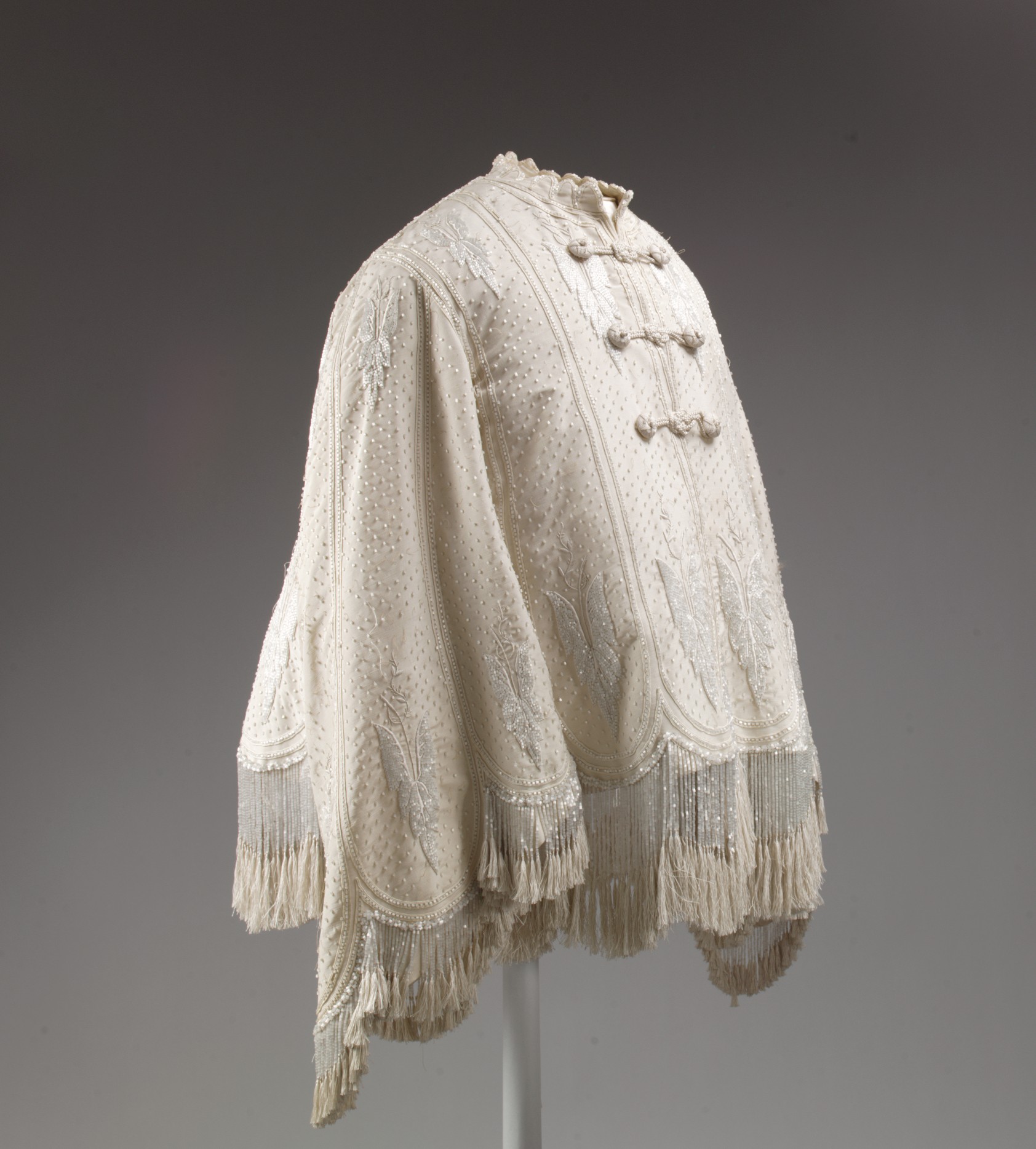
Figure 1.2 shows images of the gold-embroidered scarlet bashlik:
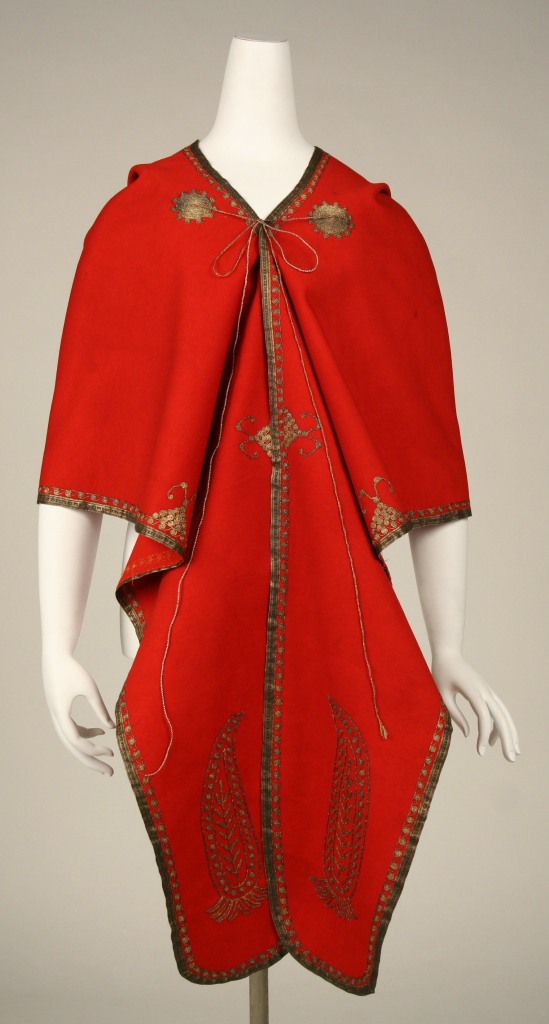

20. WHITE SILK AND LACE WRAP
Short mantle of white faille silk with insertions and vandyked borders of guipure lace; trimmed with silk cording at the neck. Part of H. M. Queen Alexandra’s trousseau.
Pictures of Queen Alexandra’s dainty and feminine-looking lace wrap can be seen in figure 1.3:

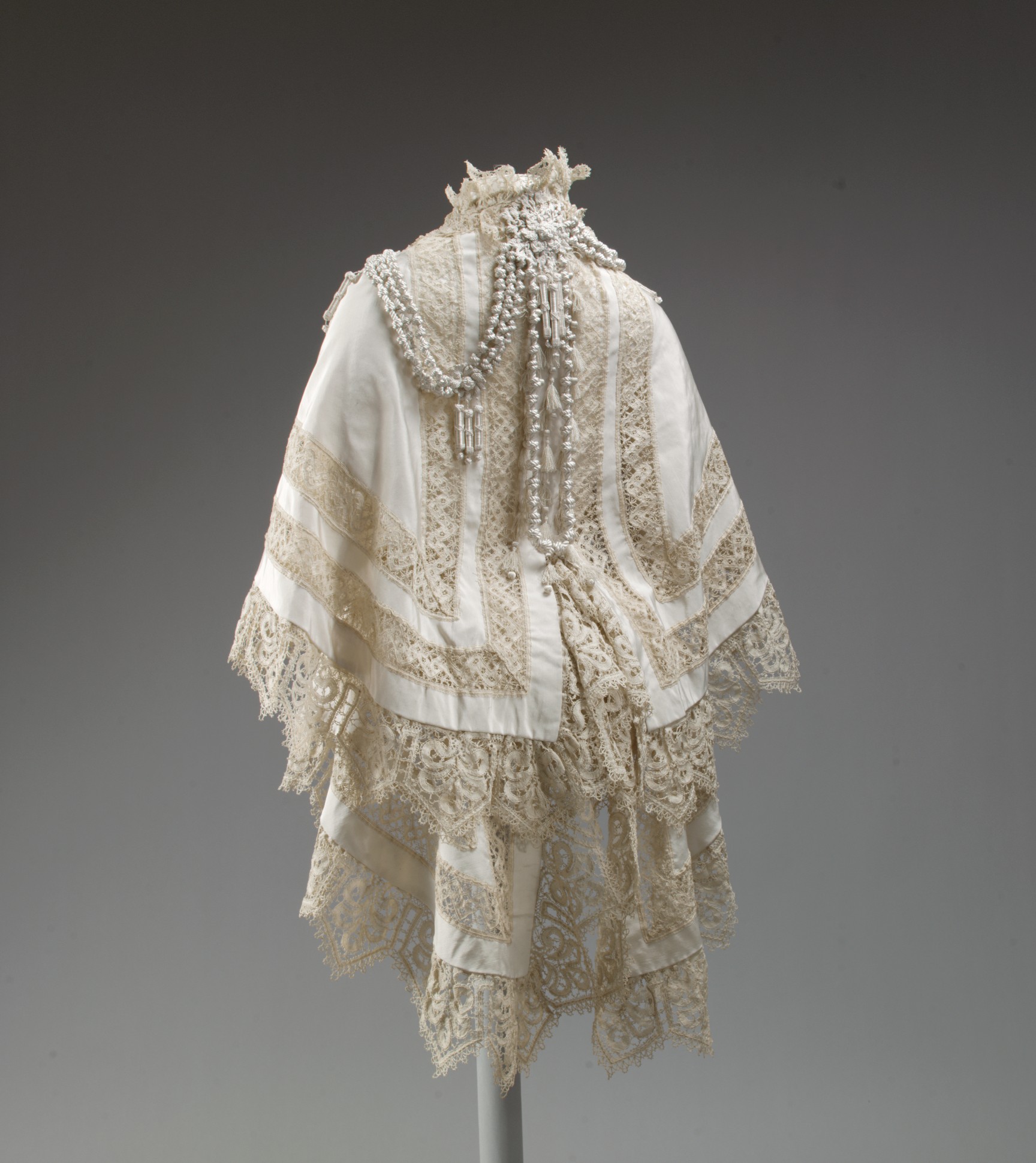
21. GOLD AND SILVER-EMBROIDERED BLUE TULLE GOWN
Light blue tulle embroidered in gold and silver beads with floral dies and broad bands at the top and hem; on blue satin foundation. Tight swathed bodice with square-cut neck and short sleeves; skirt gathered to the back with short train. Worn at King Edward’s Coronation, 1902.
Sounds lovely, doesn’t it? Blue must have been a pleasant change from Queen Alexandra’s usual colour choices at the time (i.e., black and purple, the colours of full- and half-mourning, respectively, which she favoured after the death of her son, Prince Albert Victor, in 1892). But where is it now? Unfortunately, the auction catalogue’s lack of a photograph adds to the challenge of finding the gown.
25. BLACK SEQUIN AND TULLE STATE GOWN
Embroidered with allover design and radiating stripes in sequins; black taffeta foundation, with pleated tulle flounces at hem. Separate bell-form skirt with train; three bodices, one with short sleeves of ball fringe, two with long sleeves and high necks, trimmed with ecru lace. Worn by H. M. the Queen for the State Opening of Parliament on several occasions; worn with the Garter Robe Orders, the Victoria and Albert, the Crown of India, the St. Catherine of Russia, and the Danish Royal Family Orders.
Unfortunately, this four-piece garment also seems to have disappeared and again, a photograph in the catalogue might have helped with its identification.
26. GOLD-TRIMMED BLACK WOOL COATEE
Sleeveless jacket of black wool trimmed with voltes and bands of gold braid. Part of H. M. Queen Alexandra’s trousseau.
The coatee in question was sold by Austin Auction Gallery in early 2021 (see figure 1.4). The auctioneer states that this piece was “purchased by Miss Gladys Emerson Cook (American, costume designer, active in New York City, 1899-1976) at the May 5, 1937 sale at the American Art Association Anderson Galleries in New York City, billed as an ‘unique assemblage of royal robes and state gowns, formerly belonging to H.M. Queen Alexandra, including toilettes worn at her coronation and from her trousseau.'”4 There is no doubt that this is the same coatee, as the auctioneer identifies it as lot 26 in the 1937 catalogue.
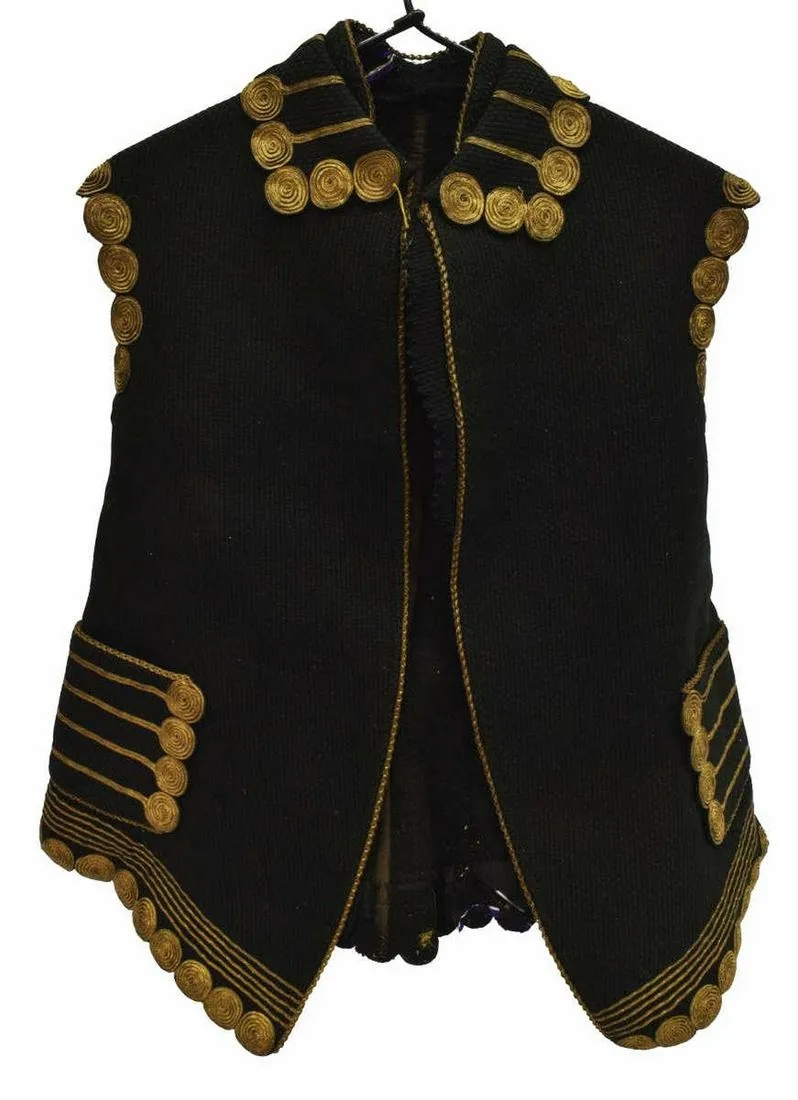

27. SCOTTISH TARTAN AND WHITE SATIN CRINOLINE BALL DRESS
Plaid satin panniers in the Royal Stuart tartan over a separate skirt of white satin ruffles outlined in red, with internal stiffening. Pointed bodice with pleated bertha trimmed with black lace, and short white tulle sleeves. With belt and separate collar. Worn at the Scottish Balls at Balmoral when H. M. the Queen first came to England.
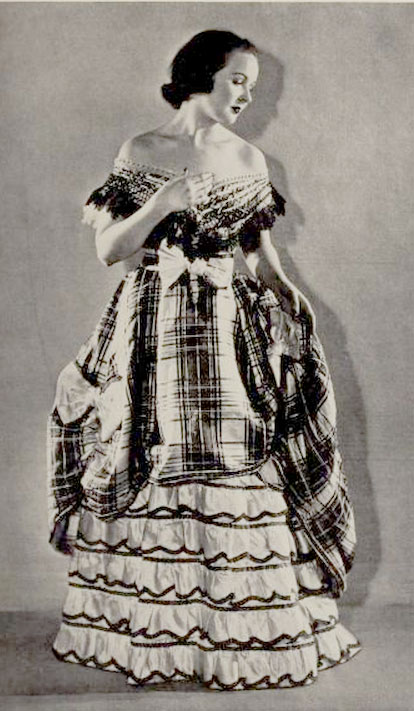
The above dress, made by Madame Elise, a London dressmaking establishment, in 1863 or so, currently resides at the Royal Ontario Museum under the accession number 942.12.1.A-E. Madame Elise also created for Alexandra a tartan-printed evening gown that dates to about 1870 and is in the collection of the Fashion Museum, Bath.
29. MAUVE CHIFFON AND PURPLE SEQUIN GOWN
Black tulle embroidered all over with graduated purple sequins, mauve chiffon underdress, on a satin foundation; separate bell-shaped skirt with train, pointed bodice with square-cut neck and collar and short bell sleeves. Worn by H. M. Queen Alexandra during the Coronation year, 1902.
A gown in the Met’s collection database (figure 1.5) seems to answer to the above description:
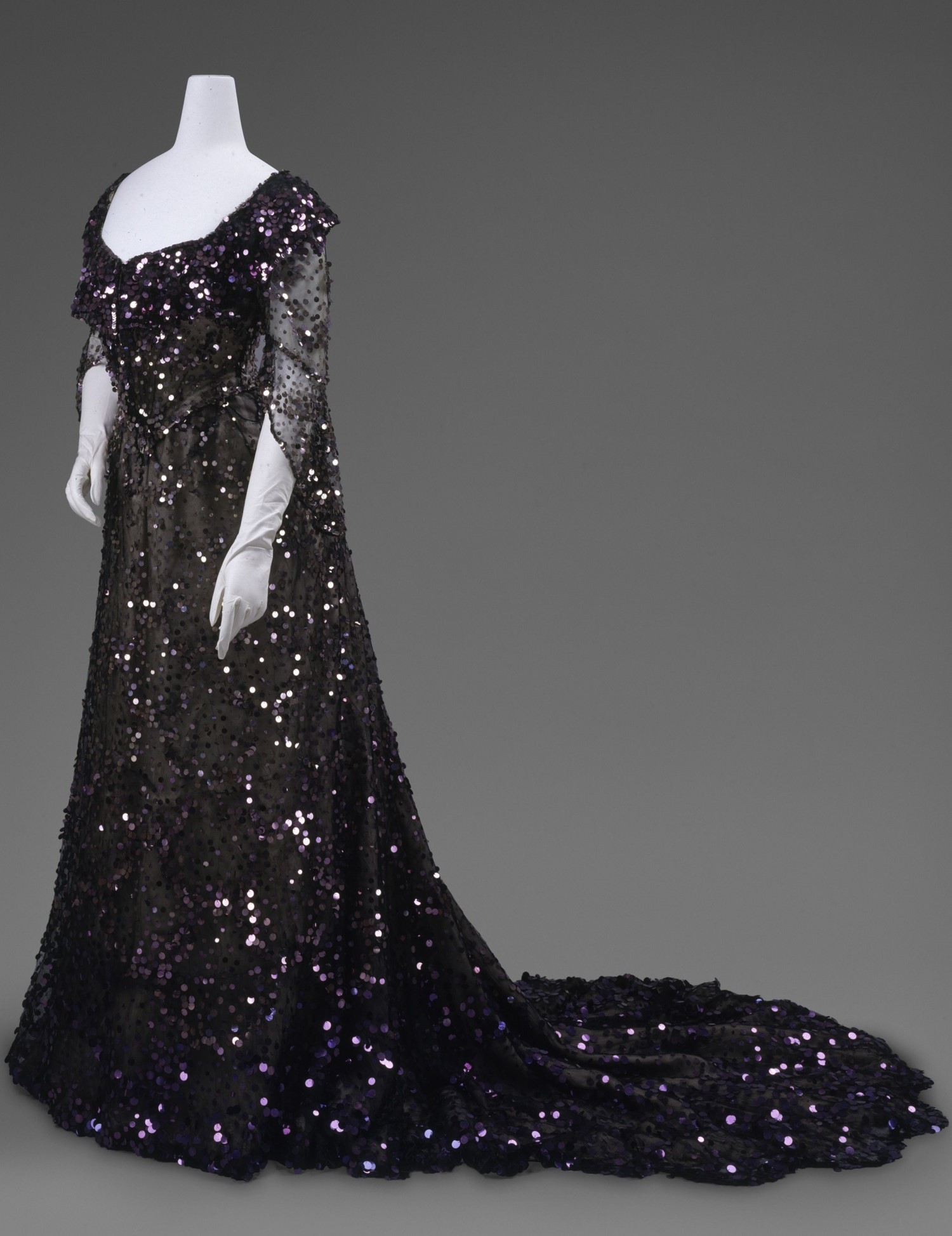
30. EMBROIDERED BLACK VELVET RIDING COAT AND HAT
Coat with flared skirt and three-quarter puffed sleeves, high lace collar, jabot, and cuffs; embroidered in gold and appliqué silks with floral borders and mock pockets. Black velvet hat trimmed with pink and black ostrich plumes. (Lot.)
The eighteenth-century inspired riding ensemble described above now resides in the Met’s collection (see figure 1.6):


In Part II, I will cover lots 31 to 70 of the auction. Stay tuned!
Notes
1. American Art Association-Anderson Galleries, Inc., Royal Robes and State Gowns, Including Toilettes Worn at the Coronation and from the Trousseau of H. M. Queen Alexandra, Comprising Coats, Kashmir Shawls, Bags, Gloves and Embroidered Slippers, with Other Examples of the Richest Fashions of the Period from 1863 to 1907: Auction in New York, May 5, 1937 (New York: American Art Association-Anderson Galleries, 1937), https://archive.org/details/royalrobesstateg00amer/page/n3/mode/2up; Kate Strasdin, Inside the Royal Wardrobe: A Dress History of Queen Alexandra (London: Bloomsbury, 2017), chap. 9, Kindle.
2. “Victorian Clothing | Auctioning a Queen’s Wardrobe,” Victoriana Magazine, accessed January 13, 2024, http://www.victoriana.com/library/queen.html.
3. Strasdin, Inside the Royal Wardrobe, chap. 9.
4. “H.M. Queen Alexandra Gold Braid Wool Coatee – Jan 17, 2021 | Austin Auction Gallery in TX,” LiveAuctioneers, accessed January 5, 2024, https://www.liveauctioneers.com/item/95229522_hm-queen-alexandra-gold-braid-wool-coatee.
Bibliography
American Art Association-Anderson Galleries, Inc. Royal Robes and State Gowns, Including Toilettes Worn at the Coronation and from the Trousseau of H. M. Queen Alexandra, Comprising Coats, Kashmir Shawls, Bags, Gloves and Embroidered Slippers, with Other Examples of the Richest Fashions of the Period from 1863 to 1907: Auction in New York, May 5, 1937. New York: American Art Association-Anderson Galleries, 1937. https://archive.org/details/royalrobesstateg00amer/page/n3/mode/2up.
Strasdin, Kate. Inside the Royal Wardrobe: A Dress History of Queen Alexandra. London: Bloomsbury, 2017. Kindle.
